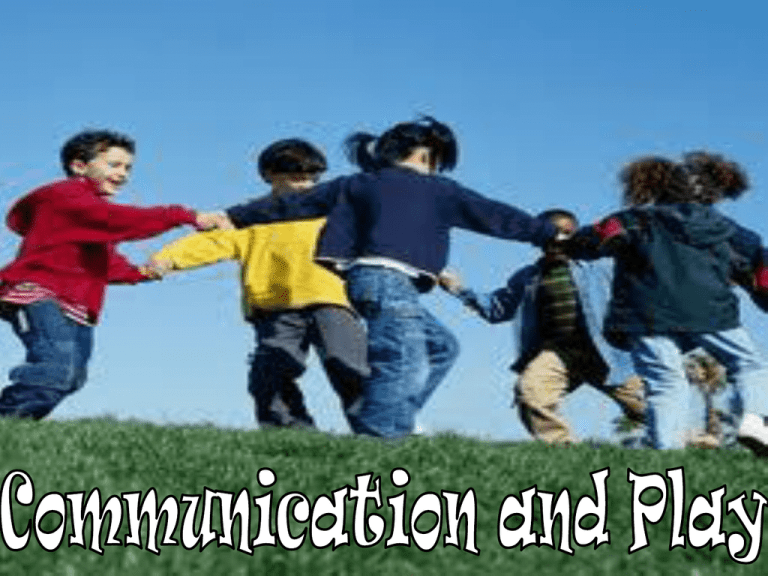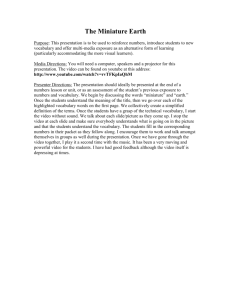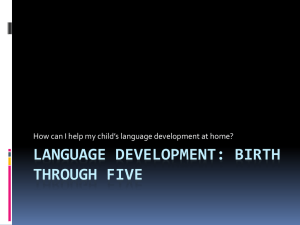Communication and Play
advertisement

When it comes to communication development in children, there is a wide range of things that classify “normal development” These standards are set in order to track your child’s progress and know what to expect of your child at certain ages If your child is significantly behind in their age group category, it would be wise to talk with your child’s doctor Child responds to their name Responds to human voices without visual cues by turning head and opening eyes Responds appropriately to friendly and angry tones http://www.youtube.com/watch?v=QBy8iNYIML4 Uses one or more words with meaning Understands simple instructions, especially if vocal or physical cues are given Practices grammar Aware of social value of speech http://www.youtube.com/watch?v=8vxgs9rbaG4 Has a vocabulary of 5-20 words Vocab made up mostly of nouns Some phrases Jargon with emotional content Able to follow simple commands http://www.youtube.com/watch?v=xBuy4Q81SeI Can name a number of objects common to their surroundings Begins to combine words into short sentences Vocabulary reaches approximately 150-300 words Controlled volume and pitch of voice Responds to commands such as “Show me your eyes (noes, mouth, hair)” http://www.youtube.com/watch?v=xCPzRr5XQV8 Correctly uses I, you, me Begins using both plural and past tenses Knows chief parts of body and can name/find them on their body Vocabulary up to 900-1000 words Can give their name, sex and age Understands routine activities (what to do when it’s time to sleep, eat, go to school) http://www.youtube.com/watch?v=-8mF23NaE6c Knows names of familiar animals Names objects in picture books or magazines Knows one or more colors Can repeat numbers Begins to play more ‘make believe’ games Can begin to use descriptive words Can typically count to ten Should be able to repeat sentences as long as nine words Defines common objects Knows age Knows tomorrow, yesterday and today Speech is grammatically correct There are different types as well as different forms of play Types of play concentrate on categories where forms of play focus more on what is happening in the situation Motor/Physical Play This type of play allows children to begin to exercise their fine motor skills through more active activities Example: A child beginning to move around the house in a walker or a toy bike Social Play This type of play comes into action when a child is involved with other children Example: Children playing together in the sandbox Here, children begin to develop their social skills as well as learn social rules such as give and take Constructive Play Constructive play is when children manipulate their environment to create things Example: Children building towers and cities with blocks, build things in the sand or draw murals on the sidewalk with chalk Fantasy Play Similar to Constructive play; here, children begin to try out new roles and possible situations. This is where children really stretch their imagination and almost create their own world Example: Playing a game of ‘Lava Monster’ on the playground Games with Rules Here, children begin to play games that follow certain rules in order to be played. This teaches children that rules must be followed in order for things to work properly Example: Follow the leader, Simon Says As children develop more and more, they will move from solitary play to group play. The different forms a child chooses to participate in may vary from day to day Solitary Play Babies usually like to spend much of their time playing on their own where they can explore their new world Older children will sometimes prefer to play on their own as well where they will learn how to draw, paint, build, create stories with dolls or explore more on their own Parallel Play From ages 2-3 children move alongside other children without much interaction with each other The children may be engaged in similar or totally different activities but they enjoy being surrounded by children their own age It may seem as though they don’t care about the presence of the other children around them but remove them from that environment and you will see a drastic change! Group Play By the age of 3 or 4 (depending on where you live) children are ready for preschool Children are able to communicate and socialize with other children and share ideas and toys with one another Here, through interactive play, children begin to learn social skills such as sharing and taking turns Children are also able to follow a “theme” of a group activity as well Example: A game like hide and go seek calls for children to be quiet and still where most other games have to do with interacting with everyone and moving around much more




